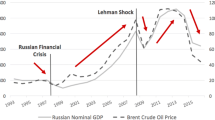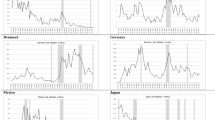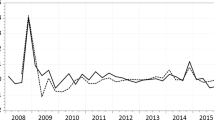Abstract
This paper examines the effects of the interaction between the oil market and measures of global liquidity on the Brazilian real against the US dollar, using an SVAR framework. The results show that approximately 15% of the variance of the real exchange rate is associated with oil-specific demand shocks in the long run. Supply and aggregate demand shocks are less important. The recovery of the Brazilian currency in the aftermath of the global financial crisis is more related to global liquidity than oil prices. Oil price changes affect the interest rate spread, which puts further pressure on the real exchange rate. Our results shed light on the impact of oil price shocks on the Brazilian economy by providing important insights into the foreign exchange policy in Brazil.





Similar content being viewed by others
Notes
For illustration, the Brazilian Finance Minister Guido Mantega coined the term “currency war” in 2010 referring to unconventional monetary policies of the Federal Reserve that triggered a tsunami of capital flows toward emerging markets, resulting in inflation, currency appreciation, and loss of external competitiveness (Eichengreen 2013).
The data from the Brazilian Agency are available in http://www.anp.gov.br/publicacoes/anuario-estatistico/5237-anuario-estatistico-2019http://www.anp.gov.br/publicacoes/anuario-estatistico/5237-anuario-estatistico-2019.
The data are available at http://comexstat.mdic.gov.br/. SITC code: 3330.
Unless otherwise noted, Brazilian currency, Brazilian real and real exchange rate are interchangeable terms, expressing the Brazilian real against the US dollar measured in real terms. Section 2.2 presents the variable details and sources.
Moreover, the proxy of liquidity (M2) for Japan is available since 2003 in the Bank of Japan.
We use the VAR lag order selection criteria for choosing the optimal lag length. The tests indicate one or twelve lags. The VAR residual serial correlation LM test can not reject the null hypothesis of no serial correlation at lags 1 to 12 for j = 4. Therefore, we chose four lags to ensure no serial correlation and parsimony. The VAR satisfies the stability condition. Section 5 contains a sensitivity exercise to an alternative lag number.
The results of formal unit root and cointegration tests are shown in Section 2.3. All the variables are difference-stationary, except for the aggregate demand, which is stationary in level. In this paper, we use the index of Kilian (2009) as a proxy of aggregate demand (details in Section 2.2). The Kilian’s real activity index is a business cycle index and, hence, must not be differenced or otherwise transformed, according with Kilian and Zhou (2018).
Section 5 contains a robustness exercise to the ordering of crude oil prices.
The data are available in the Kilian’s website (https://sites.google.com/site/lkilian2019/).
Namely, the data are from the Central Bank of Brazil, European Central Bank, Bank of Japan, Reserve Bank of India, FRED, Central Bank of Russian Federation, Bank of England and CEIC database.
The currencies used to convert monetary aggregates in local currency to US dollars are Brazilian real, Chinese yuan, Euro, Indian rupees, Japanese yen, Russian ruble and British pound.
Lee and Strazicich (2003) stress that is desirable to allow the possibility of a structural break in a unit root process, since that the rejection of the null might indicate evidence of a trend-stationary time series with breaks, when the series is difference-stationary with breaks.
The source is the FRED.
Chen et al. (2016) used 6 lags in an SVAR model with monthly data to analyze the relationship between oil prices and US dollar exchange rates. Baumeister and Peersman (2013) and Baumeister and Peersman (2012) argue that including 4 lags in a model with quarterly data (12 months) allows for sufficient dynamics in the system.
References
Anzuini A, Lombardi J, Pagano P (2013) The impact of monetary policy shocks on commodity prices. International Journal of Central Banking 9:119–144
Arezki R, Brückner M (2012) Resource windfalls and emerging market sovereign bond spreads: the role of political institutions. World Bank Econ Rev 26(1):78–99
Aslam A, Beidas-Strom S, Bems R, Celasun O, Çelik S K, Koczan Z (2016) Trading on their terms? Commodity exporters in the aftermath of the commodity boom. IMF Working Paper 16/27
Augustin P, Chernov M, Song D (2020) Sovereign credit risk and exchange rates: Evidence from CDS quanto spreads. J Financ Econ 137(1):129–151
Barone S, Descalzi R (2012) Endogenous risk premium and terms of trade shocks: evidence for developing countries. Revista de Rconom?a 19(2):7–39
Basher SA, Haug AA, Sadorsky P (2012) Oil prices, exchange rates and emerging stock markets. Energy Econ 34(1):227–240
Basher SA, Haug AA, Sadorsky P (2016) The impact of oil shocks on exchange rates: a Markov-switching approach. Energy Econ 54:11–23
Bastianin A, Manera M (2018) How does stock market volatility react to oil price shocks?. Macroecon Dyn 22(3):666–682
Bastourre D, Carrera J, Ibarlucia J, Sardi M (2012) Common drivers in emerging market spreads and commodity prices. Central Bank of Argentina Working Paper No. 12/57
Baumeister C, Kilian L (2016) Understanding the decline in the price of oil since june 2014. Journal of the Association of Environmental and Resource Economists 3(1):131–158
Baumeister C, Peersman G (2012) The role of time-varying price elasticities in accounting for volatility changes in the crude oil market. J Appl Econom 28(7):1087–1109
Baumeister C, Peersman G (2013) Time-varying effects of oil supply shocks on the US economy. American Economic Journal: Macroeconomics 5 (4):1–28
Beckmann J, Belke A, Czudaj R (2014) Does global liquidity drive commodity prices?. Journal of Banking & Finance 48:224–234
Beckmann J, Czudaj RL, Arora V (2020) The relationship between oil prices and exchange rates: revisiting theory and evidence. Energy Economics, p 104772
Belke A, Bordon IG, Volz U (2013) Effects of global liquidity on commodity and food prices. World Dev 44:31–43
Belke A, Orth W, Setzer R (2010) Liquidity and the dynamic pattern of asset price adjustment: a global view. J Banking & Finance 34(8):1933–1945
Bergholt D, Larsen VH, Seneca M (2019) Business cycles in an oil economy. J Int Money Financ 96:283–303
Bodenstein M, Erceg CJ, Guerrieri L (2011) Oil shocks and external adjustment. J Int Econ 83(2):168–184
Bouri E, Boyrie ME, Pavlova I (2016) Volatility transmission from commodity markets to sovereign CDS spreads in emerging and frontier countries. International Review of Financial Analysis 49:155–165
Bouri E, Kachacha I, Roubaud D (2020) Oil market conditions and sovereign risk in mena oil exporters and importers. Energy Policy 137:111073
Chen H, Liu L, Wang Y, Zhu Y (2016) Oil price shocks and US dollar exchange rates. Energy 112:1036–1048
Choi WG, Kang T, Kim G-Y, Lee B (2017) Global liquidity transmission to emerging market economies, and their policy responses. J Int Econ 109:153–166
Coudert V, Mignon V (2016) Reassessing the empirical relationship between the oil price and the dollar. Energy Policy 95:147–157
Cross J, Nguyen BH (2017) The relationship between global oil price shocks and China’s output: a time-varying analysis. Energy Economics 62:79–91
Dauvin M (2014) Energy prices and the real exchange rate of commodity-exporting countries. Int Econ 137:52–72
Drechsel T, Tenreyro S (2018) Commodity booms and busts in emerging economies. J Int Econ 112:200–218
Dungey M, Fry-Mckibbin R, Volkov V (2019) Transmission of a resource boom: the case of Australia. Oxf Bull Econ Stat 82:503–525
Eichengreen B (2013) Currency war or international policy coordination?. J Policy Model 3(35):425–433
Fan Y, Xu JH (2011) What has driven oil prices since 2000? a structural change perspective. Energy Economics 33(6):1082–1094
Fang C, Yang D, Meiyan W (2009) Crisis or opportunities: China’s response to the global financial crisis. Persp World Rev 1:91–113
Fernández A, González A, Rodriguez D (2018) Sharing a ride on the commodities roller coaster: common factors in business cycles of emerging economies. J Int Econ 111:99–121
Fratzscher M, Lo Duca M, Straub R (2018) On the international spillovers of US quantitative easing. Econ J 128(608):330–377
Golub SS (1983) Oil prices and exchange rates. Econ J 93 (371):576–593
Gregory AW, Hansen BE (1996) Residual-based tests for cointegration in models with regime shifts. J Econ 1(70):99–126
Herrera AM, Karaki MB, Rangaraju SK (2019) Oil price shocks and US economic activity. Energy policy 129:89–99
Hilscher J, Nosbusch Y (2010) Determinants of sovereign risk: macroeconomic fundamentals and the pricing of sovereign debt. Eur Finan Rev 14 (2):235–262
Kang H, Yu B-K, Yu J (2016) Global liquidity and commodity prices. Rev Int Econ 24(1):20–36
Kilian L (2009) Not all oil price shocks are alike: disentangling demand and supply shocks in the crude oil market. Am Econ Rev 99(3):1053–69
Kilian L (2019) Measuring global real economic activity: do recent critiques hold up to scrutiny?. Econ Lett 178:106–110
Kilian L, Lewis LT (2011) Does the Fed respond to oil price shocks?. Econ J 121(555):1047–1072
Kilian L, Park C (2009) The impact of oil price shocks on the US stock market. Int Econ Rev 50(4):1267–1287
Kilian L, Zhou X (2018) Modeling fluctuations in the global demand for commodities. J Int Money Financ 88:54–78
Kohlscheen E (2014) Long-run determinants of the Brazilian real: a closer look at commodities. Int J Financ Econ 19(4):239–250
Krugman P (1983) Oil shocks and exchange rate dynamics. In: Exchange rates and international macroeconomics. University of Chicago Press, pp 259–284
Lee J, Strazicich MC (2003) Minimum lagrange multiplier unit root test with two structural breaks. Rev Econ Stat 85(4):1082–1089
Lim JJ, Mohapatra S (2016) Quantitative easing and the post-crisis surge in financial flows to developing countries. J Int Money Financ 68:331–357
MacKinnon JG (1996) Numerical distribution functions for unit root and cointegration tests. J Appl Econom 11(6):601–618
Magalh?es AS, Domingues EP (2014) Blessing or curse: impacts of the Brazilian pre-salt oil exploration. Economia 15(3):343–362
Neary P (1988) Determinants of the equilibrium real exchange rate. Am Econ Rev 78(1):210–215
Perron P (1989) The great crash, the oil price shock, and the unit root hypothesis. Econometrica 57(6):1361–1401
Ratti RA, Vespignani JL (2013) Crude oil prices and liquidity, the BRIC and G3 countries. Energy Econ 39:28–38
Ratti RA, Vespignani JL (2013) Why are crude oil prices high when global activity is weak?. Econ Lett 121(1):133–136
Ratti RA, Vespignani JL (2015) Commodity prices and BRIC and G3 liquidity: A SFAVEC approach. J Bank Financ 53:18–33
Reinhart C, Reinhart V, Trebesch C (2016) Global cycles: capital flows, commodities, and sovereign defaults, 1815-2015. Am Econ Rev 106 (5):574–80
Shousha S (2016) Macroeconomic effects of commodity booms and busts: the role of financial frictions. Unpublished Manuscript
Souza RS, Mattos LB, Lima JE (2020) Commodity prices and the Brazilian real exchange rate. International Journal of Finance and Economics, forthcoming
Wang Y, Wu C, Yang L (2013) Oil price shocks and stock market activities: evidence from oil-importing and oil-exporting countries. J Comp Econ 41(4):1220–1239
Zeev NB, Pappa E, Vicondoa A (2017) Emerging economies business cycles: the role of commodity terms of trade news. J Int Econ 108:368–376
Zivot E, Andrews DWK (2002) Further evidence on the great crash, the oil-price shock, and the unit-root hypothesis. J Bus Econ Stat 20(1):25–44
Acknowledgements
The authors gratefully acknowledge the PNPD/CAPES scholarship program. Leonardo Bornacki de Mattos gratefully acknowledges the financial support received from the National Council for Scientific and Technological Development (CNPq) through a PQ-2 research productivity grant.
Author information
Authors and Affiliations
Corresponding author
Additional information
Data availability
The data that support the findings of this study are available from the corresponding author upon request.
Publisher’s note
Springer Nature remains neutral with regard to jurisdictional claims in published maps and institutional affiliations.
Electronic supplementary material
Below is the link to the electronic supplementary material.
Rights and permissions
About this article
Cite this article
da Silva Souza, R., de Mattos, L.B. Oil price shocks and global liquidity: macroeconomic effects on the Brazilian real. Int Econ Econ Policy 19, 761–781 (2022). https://doi.org/10.1007/s10368-022-00532-x
Accepted:
Published:
Issue Date:
DOI: https://doi.org/10.1007/s10368-022-00532-x




